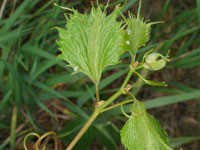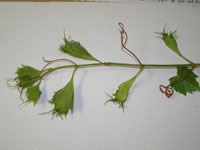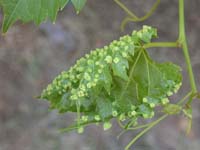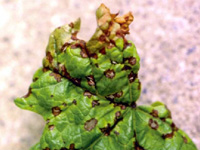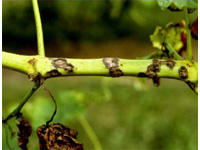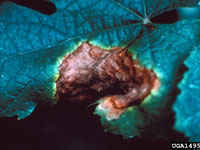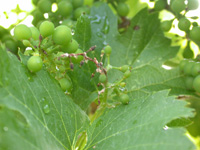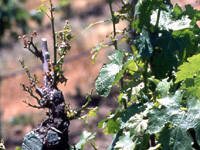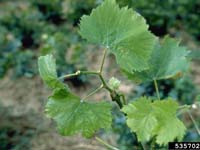Extension > Garden > Diagnose a problem > What's wrong with my plant? > Fruit > Grape > Malformed or distorted leaves
Grape > Leaves > Malformed or distorted leaves
1 of 8
Herbicide Injury
- Distorted and twisted leaves, margins of the leaf are often cupped upward
- Stunted or unusual growth of vines
- More information on herbicide injury (PDF)
2 of 8
Grape Phylloxera
- Galls are formed on the undersides of leaves from phylloxera feeding
- Leaves become cupped upward
- Present throughout the growing season
- More information on Grape Phylloxera (PDF)
3 of 8
Phomopsis Cane and Leaf Spot
Phomopsis viticola
- Leaves may be puckered along the veins or the margins may be turned under
- Dark brown spots with yellow edges can also appear along leaf veins and petioles, the lower leaves are most commonly affected
- Fruit will turn light brown and shrivel, small raised black pimple like structures may be visible on the fruit surface
- Symptoms on berries are most obvious close to harvest on maturing fruit
- More information on Phomopsis Cane and Leaf Spot
4 of 8
Anthracnose (Bird’s Eye Rot)
Elsinoe ampelina
- Leaves develop circular lesions with gray centers and brown or black margins, the center of the leaf spot may fall out resulting in small ragged holes in the leaf
- Infected shoots develop spots that become sunken lesions with gray centers and dark reddish-brown raised edges
- Infected shoots may be confused with hail damage; but unlike hail damage, the edges of the lesions are raised and black
- Berries develop small, reddish circular spots that average 1/4 inch in diameter that may become sunken with a dark brown to black margin, resembling a “bird’s eye”
- Berries are susceptible from bloom to veraison
- Infection is more prevalent in rainy years
- More information on Anthracnose (Bird's Eye Rot)
5 of 8
Botrytis
Botrytis cinerea
- Leaves have large, red-brown patches; a gray mold may or may not be observed on the leaf
- Berries become soft and watery, and may be covered in a fuzzy white-gray mold
- White grapes will start to turn brown while purple grapes turn reddish in color
- Berries that have been infected for several days will shrivel and drop to the ground as hard mummies
- Multiple berries in a cluster can be infected
- More information on Botrytis
6 of 8
Eutypa Dieback
Eutypa lata
- Young leaves will appear smaller, cupped and chlorotic
- Shoots are stunted (shortened internodes)
- Shoots growing on infected canes will appear deformed and discolored
- A canker that is flat in appearance develops on older woody vines, often around old pruning wounds
- Symptoms usually only seen in vines >6 years old
- More information on Eutypa Dieback
7 of 8
Tomato/Tobacco Ringspot Virus Decline
- Leaves exhibit a random pattern of yellows and greens or leaf yellowing in first year of infection
- Smaller leaves, shorter internodes, and reduced yield are evident in second year
- Growth is severely stunted in the third year
- Fruit clusters are sparse with uneven ripening
- More information on ringspot virus decline
8 of 8
Fanleaf Degeneration
Grapevine Fanleaf Virus
- Leaves are fan-shaped (resembling 2,4-d injury)
- Leaves may develop a bright yellow mosaic pattern or yellow vein banding
- More information on Fanleaf Degeneration




